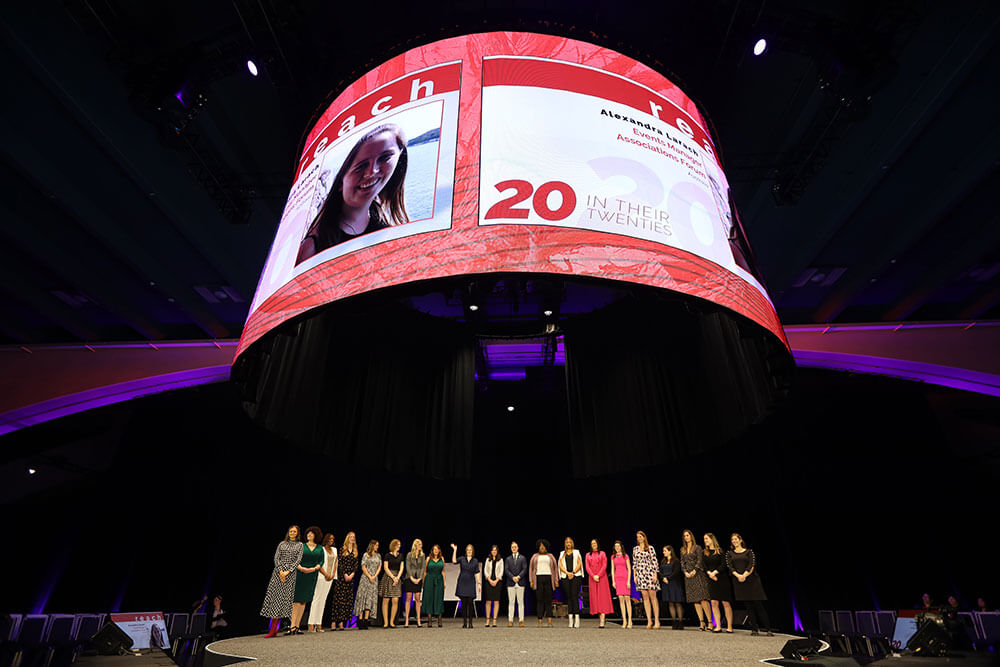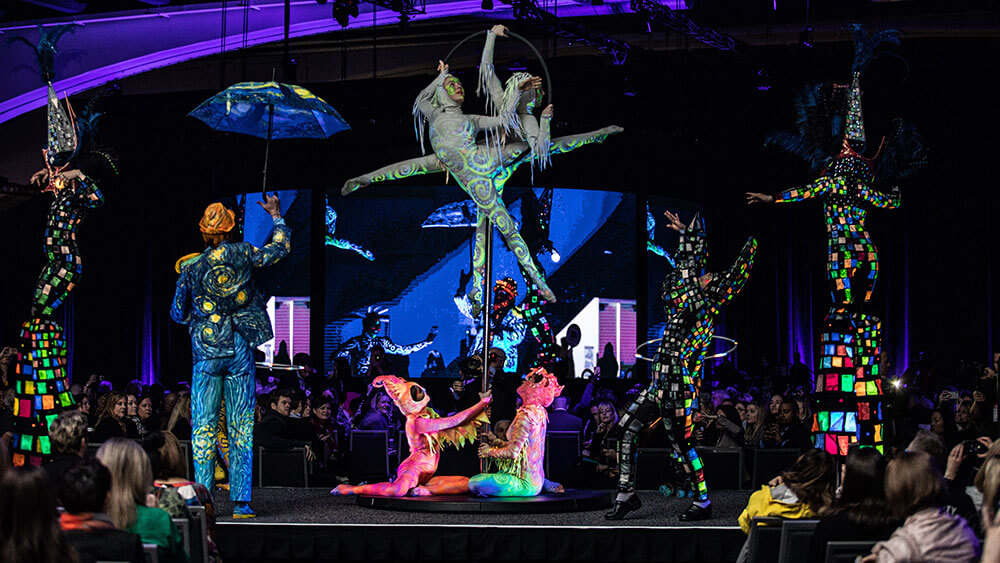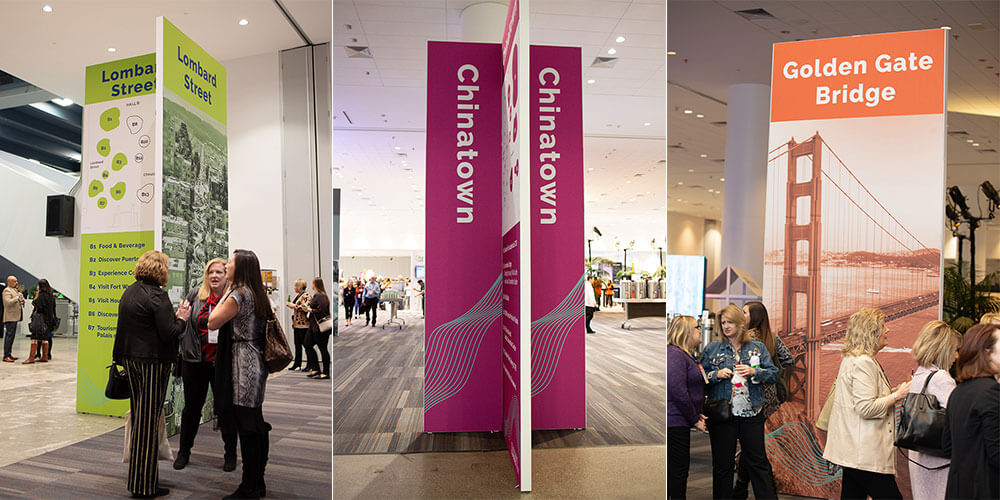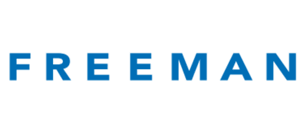
A massive, circular screen above Convening Leaders 2020 Main Stage rose and descended at different moments during the program. It created an arena-like atmosphere in Hall C of Moscone South in San Francisco. (Jacob Slaton Photography)
Event organizers know that reaching the end of a closing general session at an annual meeting might feel like closure, but it’s fleeting. It just means the start of something else: moving on to start the design-thinking process for the next annual program. Jason Hecker, the creative lead of the Freeman team that works on the Main Stage at PCMA Convening Leaders, looks at that time on the calendar with a mix of enthusiasm and uncertainty. “It’s exciting and overwhelming to look at that blank canvas,” said Hecker, who has worked on PCMA’s signature event for the past three years. “We start the design process very early by walking through the [convention] center to determine how it will look, and the answers are not always obvious.

Jason Hecker
“When you’re walking into a big space, there are no lines drawn yet,” he added. “It takes a lot of innovation and vision to decide where everything belongs. There are intrinsic challenges with any big space, so the goal is always to use it to the best advantage and never let those challenges feel apparent to the audience.”
Especially when the audience — as was the case in Hall C of Moscone South in San Francisco in January — happens to be business events professionals, who are sizing up the production through experienced eyes. The center point of the Convening Leaders 2020 stage was a massive circular screen, which rose and descended dramatically at certain points during the program. The screen not only provided a good line of sight from seating angles, it created an arena-like ambience with its wow factor. But even so, Hecker acknowledged that even the most awe-inspiring setup has its limits when it comes to maintaining attendee attention.
“We know that our audience arrives bright-eyed and bushy-tailed on Monday morning,” Hecker said. “But there is a natural attrition that occurs during the lifecycle of a conference. They’ve seen it, and they know what’s coming. So our goal was to design the content and the experience to surprise and delight attendees each day.”
With that in mind, one of the most engaging elements of the Main Stage atmosphere was actually not on the stage. A smaller secondary stage, located more toward the middle of the audience, offered some in-the-crowd experiential moments similar to stages at the Grammy Awards, including a live artistic interpretation of some of the keynote speeches by graphic recorder Michelle Boos-Stone, and a DJ set that welcomed attendees as they arrived on Tuesday morning.
While Hecker aimed to give the audience something fresh to experience each time they walked in, he also needed to carry the event’s thread throughout all three days. “The theme of REACH was central to the design journey,” Hecker said. “And we worked with San Francisco Travel to identify some local acts to help us bring the theme to life.”
A troupe from the San Francisco Bay Area Theatre Company appeared on the Main Stage throughout the conference and delivered performances that aligned with the theme, including three original songs. “The audience knew about the big speakers in advance of the program, but the performers were all something they hadn’t seen before,” Hecker said. “All the acts were also instrumental in defining what REACH means and showcasing the creativity of San Francisco.”

The Velocity troupe performs Jan. 6 before a Main Stage presentation. The smaller, secondary stage located near the middle of the audience, offered experiential moments. (Every Angle Photography)
Establishing a Sense of Place
Attendees had a chance to see more of the creative spirit of the host destination at receptions held at Pier 48 and the Chase Center, but they also could orient themselves to the city as soon as they stepped into the Innovate and Elevate Arena in Halls B and D. “When we started working with the PCMA team, one key objective that emerged was the need for a sense of place and to help make people aware of their [larger] surroundings,” said Hollin Koh, client solutions manager at Freeman.

Hollin Koh
That sense of place is a trend — connecting attendees with the local culture leads to more memorable events — identified in The Future of Meetings and Events, a joint research project conducted by Marriott and the PCMA Foundation that was released last year. Koh, who helped lead the design process for the layout of the sponsorship activations scattered throughout the arena, said that using landmarks like Alcatraz, the Golden Gate Bridge, and Fisherman’s Wharf as signage markers helped bring the outside in. It also helped eliminate the potential challenges of finding colleagues in a crowd. “We wanted to make sure that people knew how to navigate the area,” Koh said. “And the markers were a reminder of the beauty of San Francisco and all of Northern California.”
Before the memories of San Francisco begin to fade, brainstorming for the next edition of Convening Leaders, to be held in Houston, Jan. 10–13, 2021, will soon get underway. For Koh, each Convening Leaders “feels harder and harder to top,” he said. “Everyone from the industry is there, so it’s high pressure. But we have two teams that really do bring out the best in one another, and I think that’s what leads us to be able to successfully recreate the event from scratch each year. It can only get better as we move forward.”

The sponsorship activations scattered throughout the Innovate and Elevate Arena were arranged around signage markers reflecting the neighborhoods and landmarks of San Francisco. (Every Angle Photography)
In addition to fueling the action on stage and throughout the Moscone Center, Freeman made headlines of their own in San Francisco. Go to the Freeman website to learn how the company is uniting key members of the industry to establish unified data standards.
David McMillin is a Convene associate editor.

